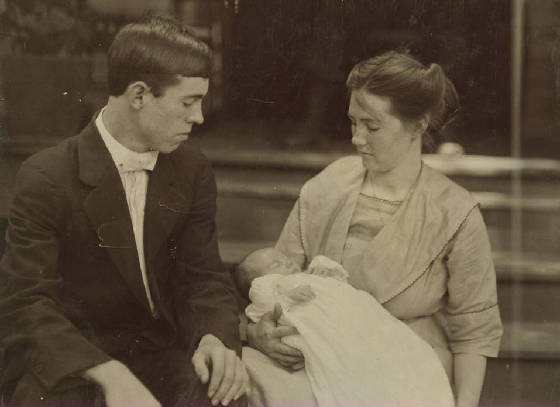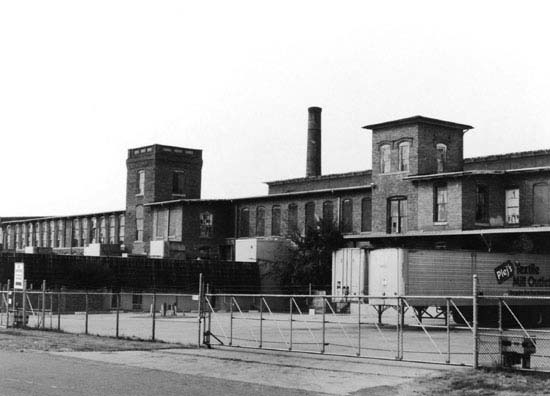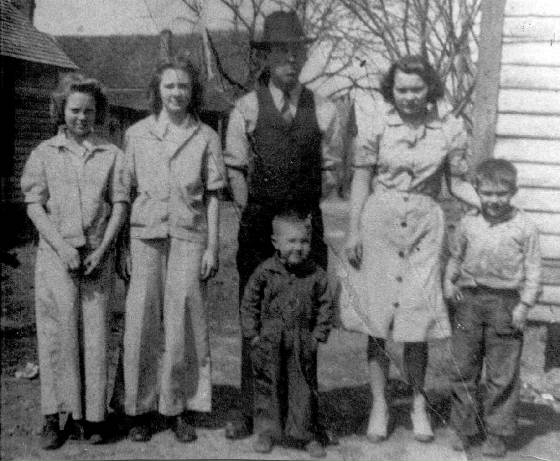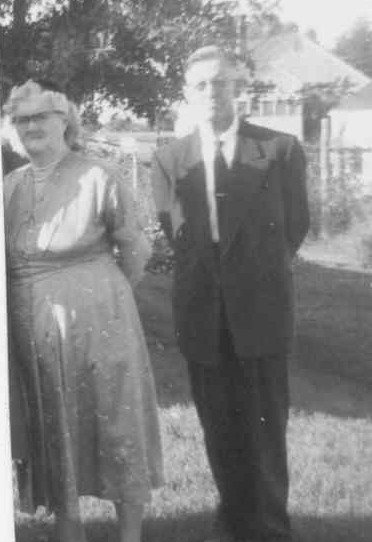
Lewis Hine caption: J.A. Leazer a 19 year old weaver and his family. Highland Park Mill, Rock Hill, S.C., Began working at 9 years. Makes $1.50 a day now and says he probably can’t get any more as a weaver. Many of them marry young. Location: Rock Hill, South Carolina. May 1912.
“My father was a bad guy. He brought another woman into our house once. He snuck her in the back door. He would come home intoxicated and just beat up on everybody, for no reason. I can still remember things like that from my childhood.” -Howard Leazer, son of James Leazer
“I always liked him. He was my uncle, and it was nice to have him around. I liked talking with him about the family when they were young. He and my mother liked to talk about old times.” -Jane Mullis, niece of James Leazer
This photograph doesn’t look much like the work of Lewis Hine. Except for the undistinguished backdrop and the reference to child labor in the caption (“began working at 9 years”), it looks more like a professionally done portrait of a handsome young couple with their first child. It was disappointing when I later found out that the Leazers were headed for great difficulties.
According to the National Park Service, the Highland Park Mill, formerly the Rock Hill Cotton Factory and the Standard Mill, opened in 1889. The company sold stock to the general public, among them school children who pooled their money to buy shares. Beginning in 1898, the mill grew to include several related structures, including a cotton oil mill, a seed house and a mill village. The mill operated until 1968, and is listed on the National Register. The complex was recently converted to senior housing.
It didn’t take long to identify the people in the photo. South Carolina posts a lot of its birth and death records online. An obituary led me to the couple’s son, Howard, and a niece, Jane Mullis. Neither had seen the photo.
James Arthur Leazer was born in Rock Hill on May 17, 1893. He was one of at least seven children born to David Leazer and Melinda (Atkins) Leazer, who married in about 1890. Both parents worked in the mill as weavers. James Leazer married Mary Collins in about 1911. Sadly, their first child, Ruby, the baby in the photo, died of meningitis in 1921, at the age of nine. Their next child, James, died of dysentery in 1915, at the age 15 months. Their last child, John, was born in 1940 when James and Mary were both about 47 years old. John died of influenza seven months later. According to their son, Howard, his parents had 14 children, seven of which survived until adulthood.
After a marriage fraught with turmoil, James and Mary separated in 1946. She passed away in 1959, at the age of 66. He passed away in Charlotte, North Carolina, on April 12, 1973, at the age of 79.


“This photo was taken in front of my house on Railroad Avenue in Rock Hill. The front of our house faced the main line of the Southern Railroad, and the rumbling of the long line of freight cars would lull me to sleep.” -Howard Leazer
Edited interview with Howard Leazer (HL), son of James Leazer. Interview conducted by Joe Manning (JM) on September 5, 2008.
JM: What did you think when you saw the picture?
HL: It was just overwhelming. That was 1912, and I was born in 1932. I had never seen my mother or my father looking so youthful. They were both very handsome folks at that time. I was amazed, and so was my one surviving sister when she saw it. My mother had 14 children. My oldest sister, Ruby, the baby in the picture, only lived a few years.
JM: How many of the children survived until adulthood?
HL: Only seven. I think there were two born after me, and one lived about six months and the other not much longer. Probably all these kids that died – if someone had taken them to a doctor, or they could have afforded to take them to a doctor – they might have lived. My mother and father separated in 1946.
JM: Why did they separate?
HL: My father was a bad guy. He brought another woman into our house once. He snuck her in the back door. He would come home intoxicated and just beat up on everybody, for no reason. I can still remember things like that from my childhood. I remember one time he hit me with a two-by-four. When they split up, I don’t know where he went, but then he showed up at our house again one time when my mother was home. I was working at the cotton mill, and she came and told me that my father was at the house and that he was drunk. So I started toward home right away, and he met me about halfway, and he had a knife in his hand. He looked like he was going to attack me. That was about 1949.
JM: How was he able to work and support such a large family, will all the problems that he had?
HL: My mother did it all. She would have a baby one day, and go to work the next day.
JM: Was that at the Highland Park Mill?
HL: No, that was before I was born. This was at the Victoria Mill, also in Rock Hill. Both my parents were weavers there.
JM: How did your mother take care of the children while she was working?
HL: One of the older siblings took care of us.
JM: Did most of your siblings go to school?
HW: Yes, but none of them graduated from high school, including me. I dropped out in the eighth grade and went to work in the mill. I worked there till I was 17, and then went into the Navy. At the beginning of WWII, my oldest sister was married and had a child, and she and her husband moved to Baltimore and worked at the old Martin Company, which is now Lockheed Martin. My two other sisters followed her up there during the war years and worked there, too. When I got out of the Navy, in 1953, I went to work as a machinist at Martin. My wife and I got married in 1955. We first lived in Baltimore, then in Towson, near Baltimore, and then we moved to a small town in Pennsylvania just across the Maryland line. We lived there for about 20 years, and then in 1999, we moved down here to Florida.
JM: When your parents split up, how did your mother continue to support the family?
HL: At that time, it was only me and my younger brother at home. When I went into the Navy, I sent her a monthly allotment, because she was unable to work, for health reasons. At that time, the mill was about ready to shut down anyway. I went back there a few years later, and the mill and all the millhouses were completely gone.
JM: After they split up, did she have any kind of relationship with your father?
HL: No, she didn’t. I believe he moved to Delaware, where one of his sisters lived. He stayed with her for a while, and then he showed up again, in Baltimore, and stayed with me for a little while. That must have been about 1961 or so.
JM: How did that work out?
HL: He just drank all the time. I never had any kind of civil conversation with him that I can remember. He finally left voluntarily, and my wife said she found wine bottles in all the cupboards. I had an older brother who lived in Rock Hill, and I believe my father spent some time with him.
JM: I hope you don’t mind me asking the obvious question. Why did your mother put up with your father so long, and have 14 children by him?
HL: I have no idea.
JM: I know that it’s hard for a woman to deal with an abusive husband. Sometimes they are afraid to do anything about it, or they feel shamed by it.
HL: The shame was probably the main reason. Of course, that still happens today.
JM: Do you have any idea why your father was the way he was?
HL: I have no idea. He had five or six brothers and sisters, and they were all decent people.
JM: Did you know your father’s parents?
HL: Yes, but they both died in about 1946. I was 14 then. They owned a farm in North Carolina, and we had no transportation, so I never really got to know them.
JM: What was your mother like?
HL: She worked very hard. As long as I can remember, she was in poor health. When I was about nine years old, she had some kind of serious problem with her hip. They did surgery on it, but they didn’t put sutures in, and just left it open to drain. It seems like after that, she sort of went downhill.
JM: Do you think she was happy?
HL: She never appeared to be. I never saw her smile much; but I think, inside, she was happy and proud of her children. We always lived in a rented mill village house. When we kids finally got away from Rock Hill, we wound up owning our homes, which was an accomplishment in itself, given our background. I worked at the Martin Company nine years, and then I went to work for the Donut Corporation of America. They were pioneers in the donut business. The founder invented the automatic donut making machine. I worked in the machine shop about nine years and was laid off. I went back there again later and became an installation manager. I retired from there in 1994. I’ve had a good life. My wife and I have been married for 53 years. We have two children. We live in a retirement community in Florida, and we really love it here.
JM: When did your mother die?
HL: In 1959. She was 66. My father died in 1973, at the age of 79. I went to his funeral. He was buried with my mother in Baltimore.
***************************
Edited interview Jane Mullis, niece of James Leazer. Interview conducted by Joe Manning (JM) on July 22, 2008.
JM: How well did you know your uncle?
Mullis: He was my mother’s brother. He and his wife – she was called Mame – separated when they lived in Rock Hill, and he came to Charlotte, where I was living, in about 1945.
JM: Where did he work when he came to Charlotte?
Mullis: He was working at some restaurant, in the kitchen.
JM: Did he keep in touch with his children?
Mullis: Sometimes.
JM: Did he have any other jobs?
Mullis: Working in restaurants is all I remember him doing: washing dishes, short order cook, things like that. He lived by himself. My mother and father had a rooming house, and he lived there a while. He also stayed at the Charlotte Rescue Mission for a while.
JM: What kind of relationship did you have with him?
Mullis: I always liked him. He was my uncle, and it was nice to have him around.
JM: What did you like about him?
Mullis: I liked talking with him about the family when they were young. He and my mother liked to talk about old times.
JM: Did he ever tell you that he worked as a child?
Mullis: No, but my mother told me that she worked as a child.
JM: When James Leazer died in 1973, did you still know him?
Mullis: Yes, my mother and father took care of him as long as they could, and then they put him in a nursing home, and that’s where he died.


James Leazer: 1893 – 1973; Mary Leazer: 1893 – 1959.
*Story published in 2010.